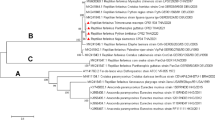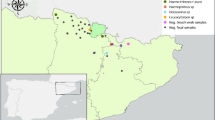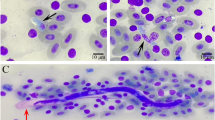Abstract
At least 12 species in the genus Bartonella are zoonotic pathogens that may be transmitted among mammalian hosts by fleas or other arthropods. Apparent host specificity by some Bartonella species to mammalian hosts has been observed, and the detection of multiple Bartonella species in mammalian fleas suggests that fleas take bloodmeals from a variety of host species. However, many flea species are observed to parasitize a narrow host range. Therefore, we suspect that fleas may acquire Bartonella by a mechanism other than ingesting infectious blood. We found that detection of multiple Bartonella genotypes and species is apparently common in fleas and that the majority of fleas tested (5/9) carried Bartonella species atypical of their hosts. We also detected Bartonella DNA in flea reproductive tissues, suggesting that vertical transmission of this organism in vectors is possible, potentially leading to the accumulation of Bartonella diversity over time within fleas.
Similar content being viewed by others
Main
The genus Bartonella consists of Gram-negative bacteria that parasitize erythrocytes and endothelial cells of mammalian hosts. Bartonellae are associated with diverse mammalian taxa (Chomel et al., 2009) and 12 Bartonella strains or species are classified as zoonotic agents (Chomel et al., 2006; Kosoy et al., 2008). Vector-borne Bartonella transmission has been reported in several systems (Chomel et al., 1996; Bown et al., 2004) and a variety of hematophagous arthropods including fleas, lice and sandflies have been implicated in Bartonella transmission among host individuals (Chomel et al., 2009).
Bartonellae are commonly detected in mammalian fleas and apparent specialization to particular mammalian hosts has been observed in Asia (Castle et al., 2004) and North America (Bai et al., 2008). In some cases, Bartonella detected in a host belongs to different species than the Bartonella detected in its fleas, and Bartonella can be detected in fleas collected from hosts that were apparently uninfected (Gabriel et al., 2009). This could result from fleas taking bloodmeals from multiple host species and Bartonella persisting and replicating in the flea gut (Finkelstein et al., 2002; Gabriel et al., 2009). However, many fleas are highly host-specific and are rarely detected on atypical hosts (Brinkerhoff, 2008). Low rates of host switching by fleas may therefore preclude acquisition of multiple Bartonella species unless fleas acquire Bartonella by mechanisms additional to the ingestion of infectious blood.
In Colorado grasslands, two dominant rodent species are the black-tailed prairie dog (Cynomys ludovicianus) and the North American deer mouse (Peromyscus maniculatus), each of which is strongly associated with one Bartonella species; B. washoensis in C. ludovicianus (Bai et al., 2008) and B. vinsonii subsp. arupensis in P. maniculatus (Bai Y, unpublished). Field sampling of over 4500 mammals revealed that the flea assemblages of these hosts are distinct with P. maniculatus parasitized primarily by Aetheca wagneri (∼93% of P. maniculatus fleas) and C. ludovicianus parasitized by Oropsylla hirsuta (∼98% of C. ludovicianus fleas) (Brinkerhoff, 2008). Carnivores in these grasslands acquire a variety of flea species and are commonly parasitized by Pulex fleas, which have wide host ranges, including rodents (Brinkerhoff, 2008). To explore relationships between Bartonella, fleas and mammalian hosts, we characterized Bartonella DNA sequences detected in fleas and blood collected from three mammalian host species.
Samples were collected from mammalian hosts (C. ludovicianus, P. maniculatus and red fox (Vulpes vulpes)) in Boulder County, Colorado, in 2005 and 2006 (methods in Brinkerhoff et al., 2008, 2009). Flea tissues were separated by dissection under stereomicroscopic observation. First, fleas were fixed to slides with commercial chemical bond and hemolymph was aspirated from between abdominal tergites. Second, the midgut and proventriculus were removed intact and were washed in sterile phosphate-buffered saline solution. Third, reproductive tissues were separated and washed in sterile phosphate-buffered saline. DNA from all tissues was extracted using the DNeasy tissue kits (Qiagen, Valencia, CA, USA). Amplification of the Bartonella citrate synthase gene (gltA) by PCR was used to detect the presence of Bartonella DNA (Norman et al., 1995), and 312 bp of the resulting amplicon was sequenced and aligned with known Bartonella species sequences (Inoue et al., 2008). For each Bartonella-positive tissue, four additional sequences were cloned and amplified from purified plasmid DNA. Bartonella in blood samples was cultured and identified using molecular methods (Bai et al., 2008).
Bartonella was detected in the blood of two P. maniculatus and in at least one tissue in 9 of 11 fleas (Table 1). Identification of Bartonella species was based on phylogenetic similarity to known Bartonella species; all DNA detected in this study matched to either the B. washoensis or the B. vinsonii arupensis clade with high bootstrap support (Figure 1). Five fleas carried Bartonella in multiple tissues, and DNA from two Bartonella species was detected in tissues of two fleas (Table 1, Figure 1). Cloning revealed that some fleas carried DNA of one sequence type, whereas others carried multiple sequence types (Table 1).
Neighbor-joining tree showing inferred relationships between Bartonella citrate synthase (gltA) amplicons derived from field-collected mammalian fleas and known Bartonella-type species. This phylogeny was constructed using the Kimura two-parameter model, and bootstrap values were calculated after 1000 replicates. Analysis was conducted using MEGA 4.0 software (Tamura and Dudley, 2007).
B. washoensis is associated with ground squirrels and, in our system, is only known from prairie dogs (Bai et al., 2008). We detected B. washoensis-like DNA in fleas collected from prairie dogs, deer mice and fox (Table 1). B. v. arupensis is associated with Peromyscus mice (Jardine et al., 2005) and was detected in P. maniculatus blood samples, yet was also detected in prairie dog and deer mouse fleas (Table 1). Furthermore, Bartonella DNA was detected in five of six fleas collected from culture-negative hosts. These results suggest that fleas harbor richer Bartonella assemblages than their hosts, and that mammals may be exposed to a wider spectrum of Bartonella than those causing bacteremia. Abbot et al. (2007) reported similar patterns of coinfection in rodent fleas and suggested that host specialization may account for mammal–Bartonella relationships. Bartonellae can ‘jump’ among host species (Jardine et al., 2005; Bai et al., 2007) and fleas have been implicated in facilitating such events (Bai et al., 2007). Our results show that fleas can acquire Bartonellae that are characteristic of multiple host species; however, flea-mediated transmission of Bartonella between prairie dogs and deer mice seems unlikely as there is little flea exchange between these hosts (Brinkerhoff, 2008; Salkeld and Stapp, 2008). Note, however, that PCR detection of Bartonella in fleas does not necessarily indicate active infection in the host just as lack of Bartonella detection by culture of host blood does not rule out low-level infection.
Bartonella detection in reproductive tissue suggests that vertical transmission is a possible alternative mechanism to horizontal transmission in fleas. If vertical transmission of Bartonella within flea lineages exists, rare host-switching events could lead to the accumulation and maintenance of atypical Bartonella species in fleas. In a study of blood-sucking flies, 100% of pupae tested positive for Bartonella DNA (Halos et al., 2004), but we are unaware of any such reports in fleas. Bartonellae may also be transmitted through arthropod feces; louse feces have been shown to support B. quintana and are implicated in inoculating humans with this pathogen (Raoult and Roux, 1999). Adult flea feces can support Bartonella (Finkelstein et al., 2002) and are an important food source for larvae.
This project was funded by a fellowship to RJB from the East Asia and Pacific Summer Institutes program of the National Science Foundation (award no. OISE-0714395) and by the Japan Society for the Promotion of Science. A number of undergraduate students at the Nihon University College of Bioresource Sciences assisted with various aspects of this research. In particular, we would like to thank Yasuhito Izumi for demonstrating to us the technique for flea tissue separation.
References
Abbot P, Aviles AE, Eller L, Durden LA . (2007). Mixed infections, cryptic diversity, and vector-borne pathogens: evidence from Polygenis fleas and Bartonella species. Appl Environ Microbiol 73: 6045–6052.
Bai Y, Kosoy M, Cully JF, Bala T, Ray C, Collinge SK . (2007). Acquisition of non-specific Bartonella strains by the northern grasshopper mouse (Onychomys leucogaster). FEMS Microbial Ecol 61: 438–448.
Bai Y, Kosoy M, Martin A, Ray C, Sheff K, Chalcraft L et al. (2008). Characterization of Bartonella strains isolated from black-tailed prairie dogs (Cynomys ludovicianus). Vector-Borne Zoonot 8: 1–5.
Bown KJ, Bennet M, Begon M . (2004). Flea-borne Bartonella grahamii and Bartonella taylorii in bank voles. Emerg Infect Dis 10: 684–687.
Brinkerhoff RJ . (2008). Mammal and Flea Occurrence in Association with Black-Tailed Prairie Dog (Cynomys Ludovicianus) Colonies: Implications for Interspecific Plague Transmission Ph.D. Dissertation University of Colorado, Boulder, Colorado, USA.
Brinkerhoff RJ, Collinge SK, Bai Y, Ray C . (2009). Are carnivores universally good sentinels of plague? Vector-Borne Zoonot 9: 491–497.
Brinkerhoff RJ, Ray C, Thiagarajan B, Cully JF, Collinge SK, Holmes B et al. (2008). Prairie dog presence affects disease vector occurrence on small rodents. Ecography 31: 654–662.
Castle KT, Kosoy M, Lerdthusnee K, Phelan L, Bai Y, Gage KL et al. (2004). Prevalence and diversity of Bartonella in rodents of northern Thailand: a comparison with Bartonella in rodents from southern China. Am J Trop Med Hyg 70: 429–433.
Chomel BB, Boulouis HJ, Breitschwerdt EB, Kasten RW, Vayssier-Taussat M, Birtles RJ et al. (2009). Ecological fitness and strategies of adaptation of Bartonella species to their hosts and vectors. Vet Res 40. ARTN 29.
Chomel BB, Boulouis HJ, Maruyama S, Breitschwerdt EB . (2006). Bartonella spp. in pets and effect on human health. Emerg Infect Dis 12: 389–394.
Chomel BB, Kasten RW, Floyd-Hawkins K, Chi B, Yamamoto K, Roberts-Wilson J et al. (1996). Experimental transmission of Bartonella henselae by the cat flea. J Clin Microbiol 34: 1952–1956.
Finkelstein JL, Brown TP, O’Reilly KL, Wedincamp J, Foil LD . (2002). Studies on the growth of Bartonella henselae in the cat flea (Siphonaptera: Pulicidae). J Med Entomol 39: 915–919.
Gabriel MW, Henn J, Foley FE, Brown RN, Kasten RW, Foley P et al. (2009). Zoonotic Bartonella in fleas collected on gray foxes (Urocyon cinereoargentteus). Vector-Borne Zoonot 9: 597–602.
Halos L, Jamal T, Maillard R, Girard B, Guillot J, Chomel B et al. (2004). Role of Hippoboscidae flies as potential vectors of Bartonella spp. infecting wild and domestic ruminants. Appl Environ Microbiol 70: 6302–6305.
Inoue K, Maruyama S, Kabeya H, Yamada N, Ohashi N, Sato Y et al. (2008). Prevalence and genetic diversity of Bartonella species isolated from wild rodents in Japan. Appl Environ Microbiol 74: 5086–5092.
Jardine C, Appleyard G, Kosoy MY, McColl D, Chirino-Trejo M, Wobeser G et al. (2005). Rodent-associated Bartonella in Saskatchewan, Canada. Vector-Borne Zoonot 5: 402–409.
Kosoy M, Morway C, Sheff KW, Bai Y, Colborn J, Chalcraft JL et al. (2008). Bartonella tamiae sp nov., a newly recognized pathogen isolated from three human patients from Thailand. J Clin Microbiol 46: 772–775.
Norman AF, Regnery R, Jameson P, Greene C, Krause DC . (1995). Differentiation of Bartonella-like isolates at the species level by PCR-restriction fragment length polymorphism in the citrate synthase gene. J Clin Microbiol 33: 1797–1803.
Raoult D, Roux V . (1999). The body louse as a vector of reemerging human disease. Clin Infect Dis 29: 888–911.
Salkeld DJ, Stapp P . (2008). No evidence for deer mouse involvement in plague (Yersinia pestis) epizootics in prairie dogs. Vector-Borne Zoonot 8: 331–337.
Tamura K, Dudley J, Nei M, Kumar S . (2007). MEGA4: Molecular Evolutionary Genetics Analysis (MEGA4) Software version 4.0. Mol Biol Evol 24: 1596–1599.
Author information
Authors and Affiliations
Corresponding author
Rights and permissions
About this article
Cite this article
Brinkerhoff, R., Kabeya, H., Inoue, K. et al. Detection of multiple Bartonella species in digestive and reproductive tissues of fleas collected from sympatric mammals. ISME J 4, 955–958 (2010). https://doi.org/10.1038/ismej.2010.22
Received:
Revised:
Accepted:
Published:
Issue Date:
DOI: https://doi.org/10.1038/ismej.2010.22
Keywords
This article is cited by
-
Cattle Farming and Plantation Forest are Associated with Bartonella Occurrence in Wild Rodents
EcoHealth (2024)
-
Rats as potential reservoirs for neglected zoonotic Bartonella species in Flanders, Belgium
Parasites & Vectors (2020)
-
Vector-Borne Pathogens in Ectoparasites Collected from High-Elevation Pika Populations
EcoHealth (2020)
-
Bartonella, Rodents, Fleas and Ticks: a Molecular Field Study on Host-Vector-Pathogen Associations in Saxony, Eastern Germany
Microbial Ecology (2016)
-
The effect of ecological and temporal factors on the composition of Bartonella infection in rodents and their fleas
The ISME Journal (2014)




